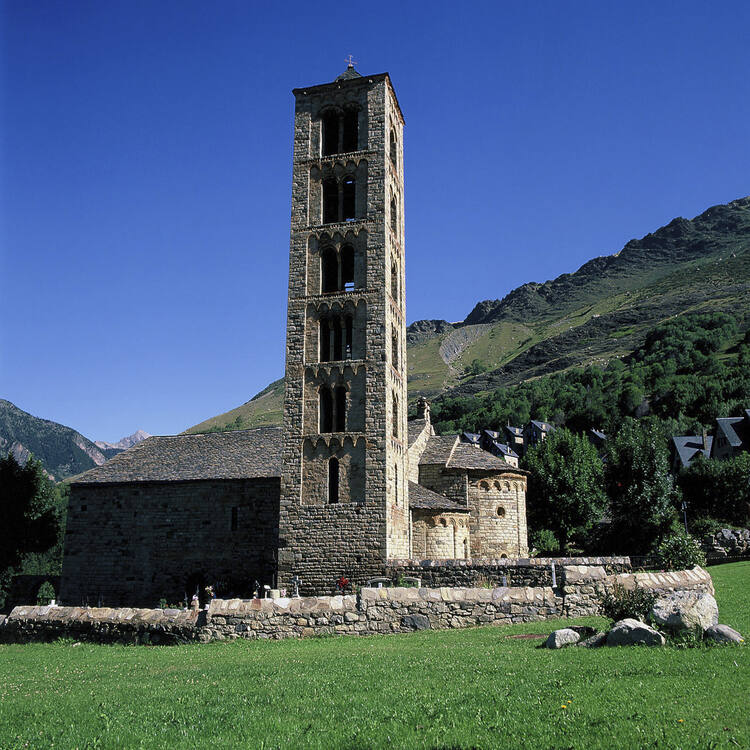Countries<Spain<Cataluña [Catalonia]<Boí< Iglesias románicas catalanas de Vall del Boí
In the Vall de Boí (province of Lleida) we find nine Romanesque temples dating from the 11th to 13th centuries, homogeneous and pure examples of the profound cultural exchanges in medieval Europe, especially across the mountainous barrier of the Pyrenees. This group of Romanesque churches was declared a World Heritage Site in 2000. One of the greatest values of this property is based on its unity: there is no other place in Europe with such a remarkable group of churches built in the same period of time that illustrates in such a vivid way the transmission of a cultural movement capable of crossing the mountain barrier of the Pyrenees.
An enclave of steep mountains is the setting for one of the finest examples of Romanesque sculpture, furniture and mural painting of its time. It has a very characteristic architectural unity that follows the models from northern Italy (Lombard Romanesque) and features slender bell towers with exterior decoration of blind arches and vertical bands. The materials used are local: stone, slate and wood, and most of the original parts have been preserved.
The nine churches that make up the declared property (Sant Climent de Taüll and Santa María de Taüll, Sant Joan de Boí, Santa Eulalia de Erill la Vall, Sant Feliu de Barruera, La Nativitat and Sant Quirc de Durro, Santa María de Cardet and la Assumpció de Coll) have one or three naves built with small granite ashlars and covered with wooden structures or barrel vaults. Above all, the bell towers stand out; slender square towers that were used for communication and surveillance of the territory and, following the models of northern Italy, have Lombard bands and blind arches that rhythmically decorate the exteriors of the apses and bell towers.
Today, the churches are in a good state of preservation. They revealed the spiritual values of the society of the time and served to instruct the faithful who attended. This interior decoration, completed with altar frontals and carvings, can be found to a large extent in the National Art Museum of Catalonia.
Encontramos en la Vall de Boí (provincia de Lleida) nueve templos románicos datados entre los siglos XI y XIII, ejemplos homogéneos y puros de los profundos intercambios culturales en la Europa medieval, especialmente a través de la barrera montañosa de los Pirineos. Este conjunto de iglesias románicas fue declarado Patrimonio Mundial en el año 2000. Uno de los mayores valores a destacar de este bien se fundamenta en su unidad: no hay otro lugar en Europa con un conjunto de iglesias tan notable construidas en un mismo período de tiempo que ilustre de una manera tan viva la transmisión de un movimiento cultural capaz de traspasar la barrera montañosa de los Pirineos.
Un enclave de montañas abruptas es el escenario donde se sitúa uno de los mejores ejemplos de escultura, mobiliario y pintura mural románica de su tiempo. Presenta una unidad arquitectónica muy característica que sigue los modelos provenientes del norte de Italia (románico lombardo) y en el destacan los esbeltos campanarios de torre con decoración exterior de arquerías ciegas y bandas verticales. Los materiales utilizados son los autóctonos: piedra, pizarra y madera y en su mayor parte se conservan las piezas originales.
Las nueve iglesias que forman el bien declarado (Sant Climent de Taüll y Santa María de Taüll, Sant Joan de Boí, Santa Eulalia de Erill la Vall, Sant Feliu de Barruera, La Nativitat y Sant Quirc de Durro, Santa María de Cardet y la Assumpció de Coll) presentan una o tres naves que se levantan con pequeños sillares de granito y se cubren con estructuras de madera o bóvedas de cañón. Por encima de todo destacan los campanarios; esbeltas torres de planta cuadrada que cumplían una función de comunicación y vigilancia del territorio y siguiendo los modelos del norte de Italia presentan bandas lombardas y arquetes ciegos que decoran rítmicamente los exteriores de los ábsides y los campanarios.
En la actualidad, el estado de conservación de las iglesias es bueno. En ellos se revelaban los valores espirituales de la sociedad del momento, sirviendo de instrucción a los fieles que acudían. Esta decoración interior, completada con frontales de altar y tallas, se encuentra en gran parte en el Museo Nacional de Arte de Catalunya.
